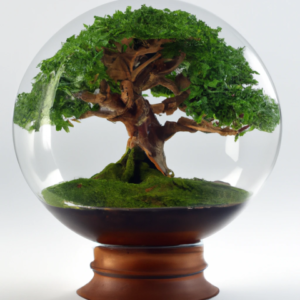I still remember my first terrarium attempt—a beautiful glass bowl that quickly became a plant graveyard.
Like many beginners, I chose plants that looked pretty but weren’t suited for closed environments.
After years of trial and error, I learned that choosing the right plants from the start leads to success.
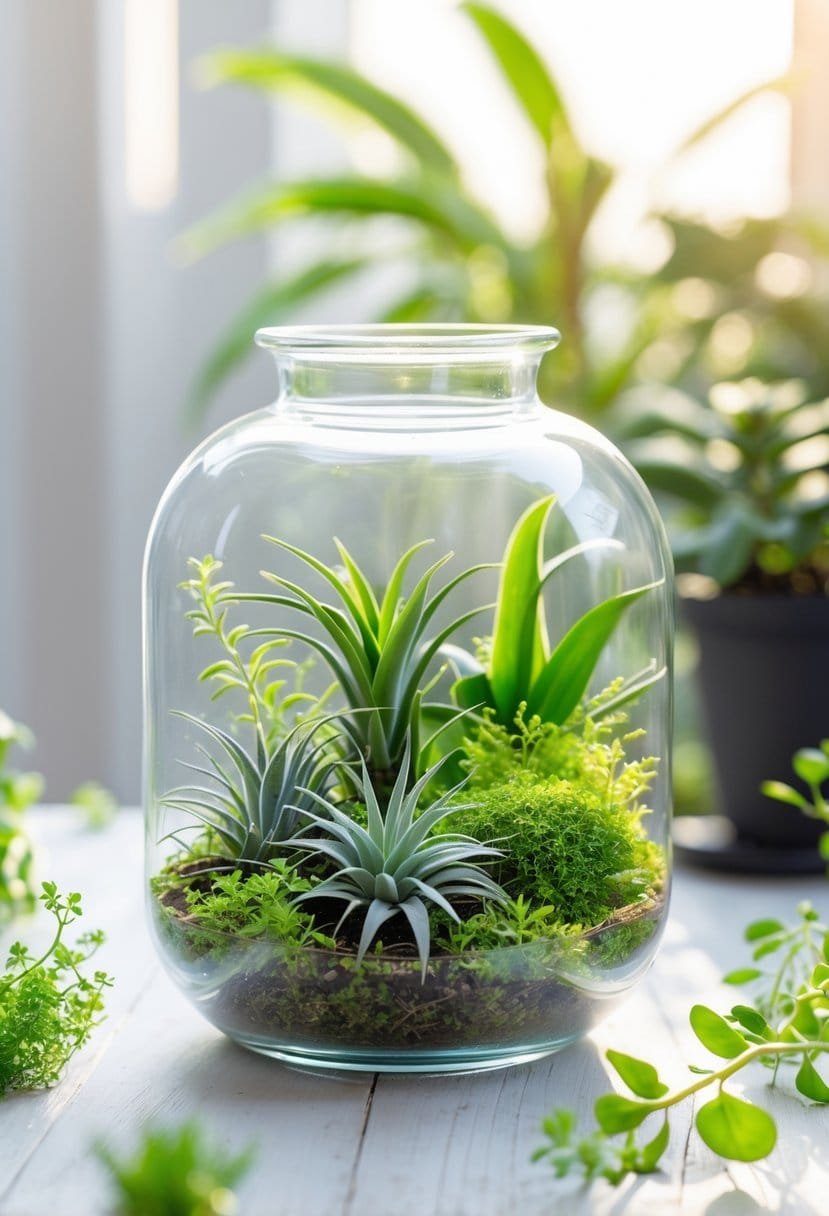
The easiest terrarium plants for beginners include nerve plants, creeping fig, moss, and various ferns. These hardy tropical plants thrive in humid conditions and need minimal care.
They forgive mistakes with watering or placement.
The key to terrarium success is understanding why certain plants thrive while others struggle.
I’ll guide you through the most reliable plant choices, from colorful options to specialty plants that create unique displays.
You’ll also get essential care tips and advice on combining plants for stunning arrangements that actually survive.
Key Takeaways
- Choose plants that love humidity and tolerate low light for the best results.
- Nerve plants, moss, and small ferns are nearly foolproof options for terrariums.
- Proper plant selection and basic care matter more than expensive equipment or complex setups.
What Makes a Plant Easy in Terrariums?
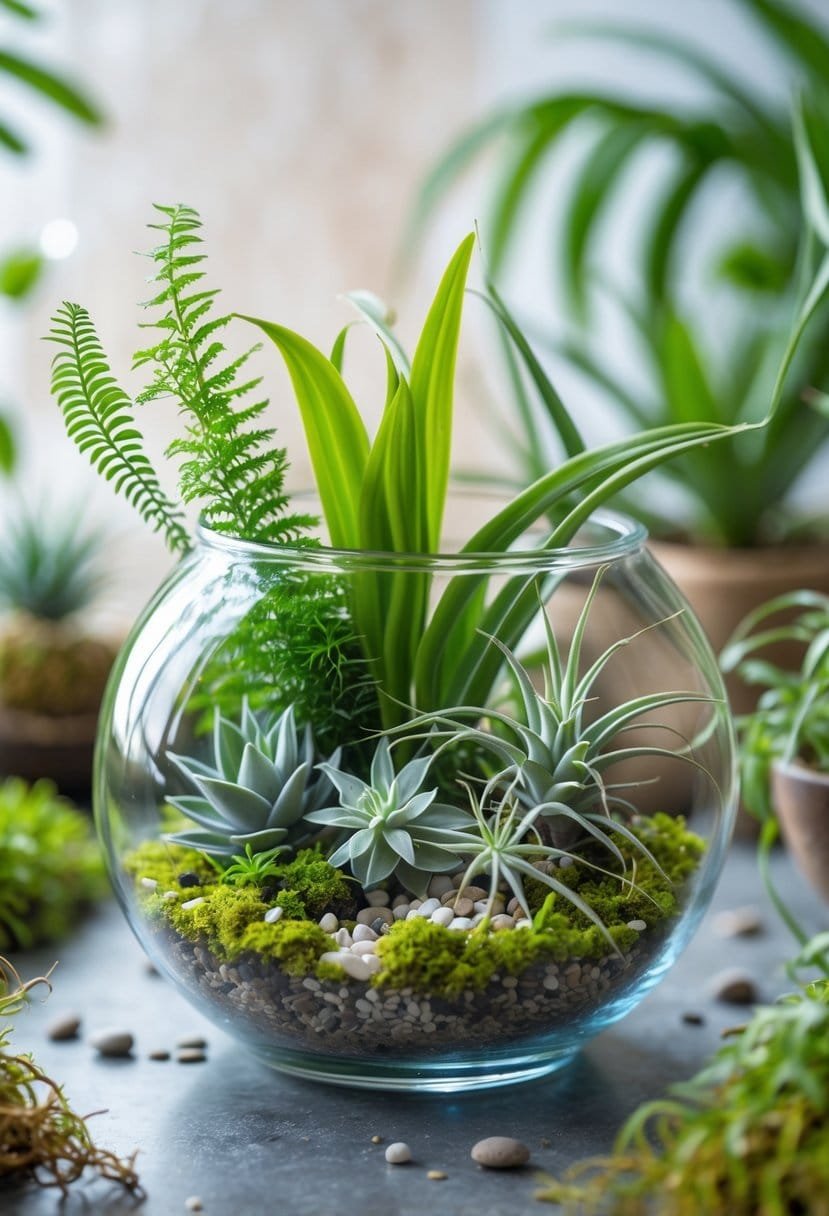
The easiest terrarium plants share traits that help them thrive in glass containers.
These plants need little care, adapt well to humidity changes, stay compact, and handle different light conditions.
Low-Maintenance Growth Requirements
The best terrarium plants need very little attention once you set them up.
They don’t require frequent fertilizing or special soil.
Most easy terrarium plants can survive weeks without watering in closed systems.
The recycled moisture creates a self-sustaining environment.
Key low-maintenance features:
- Minimal fertilizer needs
- Simple potting soil
- Infrequent watering
- No pruning for months
Plants like baby tears and nerve plants actually thrive when left alone.
They perform better with less fuss.
Many easy houseplants for terrariums come from tropical regions with consistent conditions.
This background makes them perfect for the stable environment inside glass containers.
Adaptability to Terrarium Environments
Good terrarium plants handle the unique conditions inside glass containers.
They cope with limited air and higher humidity than most indoor plants.
Humidity-loving plants like ferns and mosses excel here.
They absorb moisture through their leaves and don’t mind the still air.
Adaptable plant characteristics:
- High humidity tolerance
- Survive with limited air circulation
- Handle stable temperatures
- Regulate moisture and avoid root rot
Plants from rainforest floors adapt quickly to terrarium life.
They already tolerate low light and high moisture.
Some plants even prefer terrarium conditions.
Artillery ferns and aluminum plants show brighter colors and fuller growth in glass containers.
Compact Size and Slow Growth
The best terrarium plants stay small and grow slowly.
I look for plants that naturally stay under 6 inches tall.
Ideal size characteristics:
- Maximum height: 4-8 inches
- Spread: Less than container width
- Shallow roots
- Slow to moderate growth
Small plants like dwarf conifers and mini succulents keep their shape and won’t take over the terrarium.
Slow growers mean less maintenance.
I don’t need to trim or transplant them often.
Plants that produce offsets or runners fill a terrarium nicely without getting overwhelming.
Hens and chicks form attractive clusters and stay the right size.
Tolerance to Varying Light and Moisture
Easy terrarium plants handle changes in watering and lighting without stress.
This makes them perfect for beginners.
Low light plants like mosses and ferns do well because most terrariums get filtered light, not direct sun.
Light and moisture flexibility:
- Bright indirect light
- Survive occasional dry spells
- Handle both wet and slightly dry soil
- Adapt to seasonal changes indoors
I prefer plants that work in both open and closed terrariums.
This gives me more options for my setups.
Plants like pothos and nerve plants recover quickly from watering mistakes.
They show clear signs when they need help but don’t die from minor neglect.
Types of Terrariums and Ideal Beginner Plants
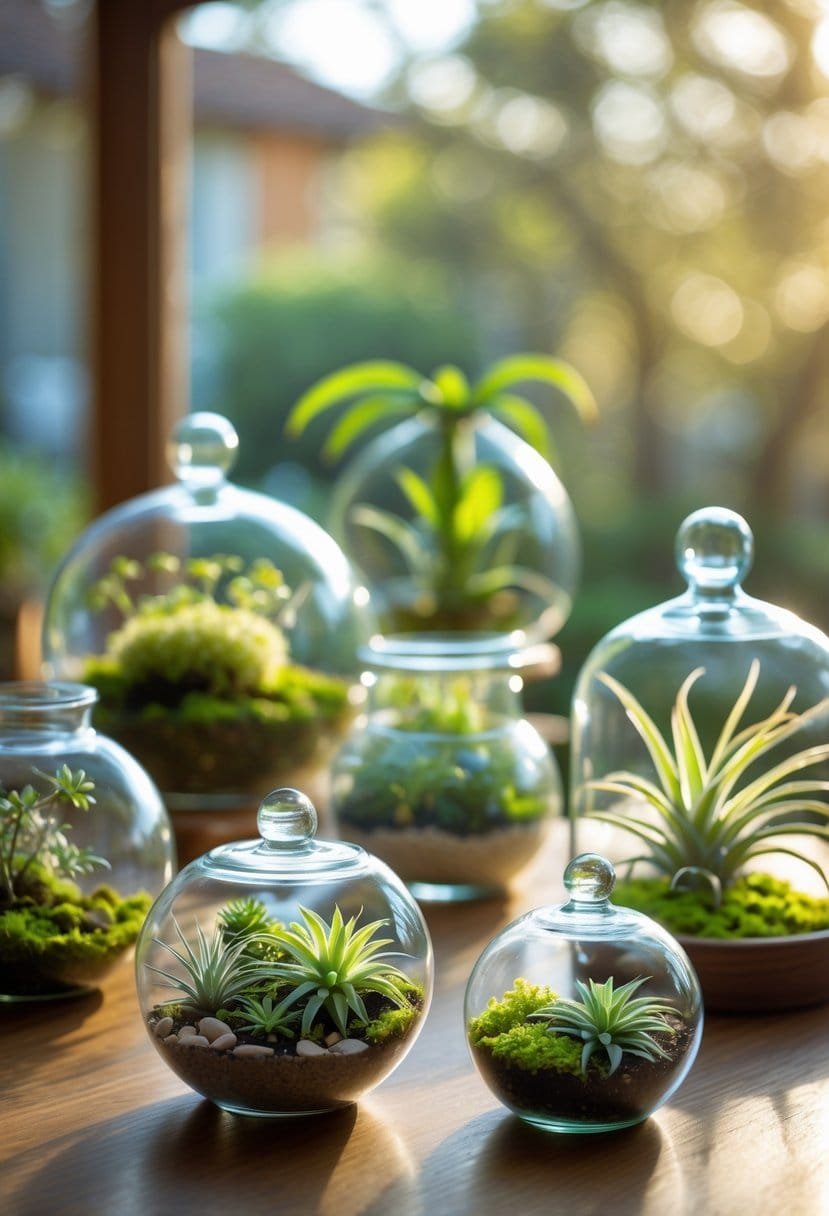
The two main types of terrariums—closed and open—need different plants.
Closed terrariums offer humid conditions for tropical plants.
Open terrariums suit plants that like drier air.
Closed Terrariums: Best Plants and Benefits
Closed terrariums act like mini greenhouses.
They trap moisture inside, creating humid conditions perfect for tropical plants.
Best Plants for Closed Terrariums:
- Nerve Plants (Fittonia)
- Baby Ferns
- Small Orchids
- Moss
- Peperomia
I rarely need to water these plants.
The water cycle inside the glass keeps them hydrated for weeks.
Closed terrariums also protect plants from dry indoor air.
This makes them great for homes with heating or air conditioning.
Open Terrariums: Suitable Plants and Care
Open terrariums have no lid, so they dry out faster.
These are better for plants that dislike wet roots.
Best Plants for Open Terrariums:
- Succulents (jade, echeveria, haworthia)
- Cacti (small varieties)
- Air Plants
- String of Pearls
I water open terrariums more often, usually once a week.
The fresh air prevents fungal problems.
Open terrariums also let me use decorative sand or rocks without worrying about mold.
Matching Plant Choices to Terrarium Type
Match plants to the moisture level of each terrarium type.
Tropical plants need the humidity of closed systems.
Desert plants prefer open designs.
Closed Terrarium Plants Need:
- High humidity (60-80%)
- Indirect light
- Minimal watering
- Warm temperatures
Open Terrarium Plants Need:
- Low humidity (30-50%)
- Bright light
- Regular watering
- Good air flow
I always check if a plant is tropical or desert before choosing my terrarium type.
Terrarium plants are ideal for beginners because they create controlled environments that are easier to manage than regular houseplants.
Top Easiest Terrarium Plants for Beginners
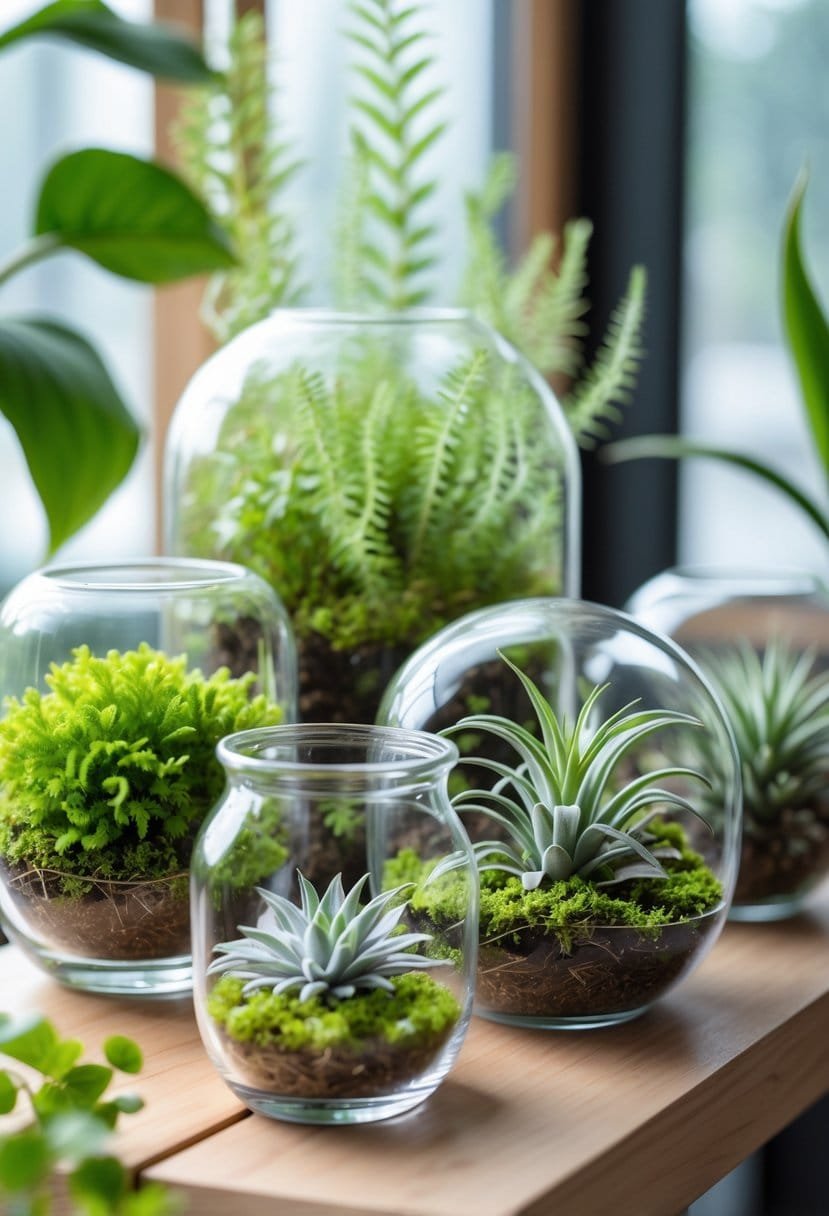
Ferns thrive in humid conditions and need little care once established.
Mosses create beautiful ground cover and help keep moisture levels steady.
Vining plants add height and are forgiving for new terrarium gardeners.
Ferns and Fern Varieties
Button fern (Pellaea rotundifolia) is my top pick for beginners.
This New Zealand native has small, round leaves that look delicate.
Button ferns tolerate dry soil at times, making them good for open terrariums.
They prefer filtered light and weekly watering.
Maidenhair fern works well in closed terrariums with steady humidity.
Its delicate fronds add elegance to any setup.
I recommend starting with button fern if you’re new to terrariums.
It’s more drought-tolerant than most ferns.
Lemon button fern offers the same easy care and adds a bright yellow-green color.
These ferns grow slowly, so they won’t outgrow your container.
Trim any brown fronds to keep them looking fresh.
Mosses and Ground Cover Plants
Sphagnum moss (Sphagnum capillifolium) is both practical and decorative.
It stores water for other plants and works in open or closed setups.
I mist sphagnum moss lightly once a week.
It prefers indirect light and shade.
Selaginella or spikemoss creates a carpet-like ground cover.
This plant looks like moss but is actually a primitive vascular plant.
Selaginella needs steady moisture and high humidity.
It works best in closed terrariums.
Baby tears (Soleirolia soleirolii) forms dense, low mats.
It goes by many names, including angel’s tears.
Baby tears behave well in closed terrariums.
They need bright light and steady moisture.
Vining and Trailing Plants
Pothos (Epipremnum aureum) is almost indestructible in terrariums.
Golden pothos is famous as a tough houseplant.
I prune pothos regularly to keep it tidy.
It handles low light and grows easily in water.
Creeping fig (Ficus pumila) has small, heart-shaped leaves that add texture.
This vine can climb structures in larger terrariums.
Creeping fig prefers warm, moist, closed terrariums.
You can propagate it by rooting cuttings in water.
Both plants need occasional trimming to keep their shape.
They’re perfect for adding vertical interest with little special care.
Colorful and Decorative Plants That Are Easy to Keep
These vibrant plants bring stunning patterns and colors to terrariums and need minimal care. Each species has unique leaf designs with pink, red, or purple markings that create visual interest for beginners.
Polka Dot Plant
The polka dot plant (Hypoestes phyllostachya) grows bright green leaves dotted with pink, red, or white spots. This plant suits beginners because it tolerates watering mistakes.
Light Requirements:
- Bright, indirect light is best
- Direct sun fades the colorful spots
- Low light reduces color vibrancy
Polka dot plants thrive in humid terrarium settings. They prefer moist soil but can handle the occasional missed watering.
Care Tips:
- Water when the top inch of soil feels dry
- Pinch off flowers to keep leaves colorful
- Mist regularly for added humidity
These plants stay compact in terrariums, usually reaching 6-12 inches tall. Their colorful foliage stands out against green plants.
Nerve Plant (Fittonia)
Fittonia displays white, pink, or red veins on dark green leaves. Nerve plants work well for beginners because they adapt easily to terrarium life.
These plants love high humidity, making closed terrariums ideal. Their striking vein patterns add bold color.
Growing Conditions:
- Light: Bright, indirect light
- Water: Keep soil consistently moist
- Humidity: High (60-80%)
- Temperature: 65-80°F
Nerve plants grow low and spread outward, serving as excellent ground cover. They rarely grow taller than 6 inches.
Vein patterns come in several varieties. White-veined types look elegant, while pink and red varieties add vibrant color.
Prayer Plant
The prayer plant (Maranta leuconeura) folds its leaves upward at night, resembling praying hands. This plant combines beautiful patterns with interesting movement.
Distinctive Features:
- Dark green leaves with light green markings
- Red veins create contrast
- Purple undersides add color
- Leaves move during the day
Prayer plants prefer warm, humid terrarium conditions. They need consistent moisture and good drainage to avoid root rot.
Care Requirements:
- Indirect light prevents burning
- Water when the top inch of soil dries
- High humidity keeps leaves healthy
- Temperatures between 65-75°F
These plants stay small, growing 8-12 inches tall. Their patterns and leaf movement make them captivating in terrariums.
Popular Foliage Plants for Effortless Terrariums
These foliage plant families have distinct leaf patterns and colors and need little care. Each type adds visual appeal with different growth habits and leaf shapes.
Peperomia and Its Varieties
Peperomia plants are among the easiest terrarium plants for beginners. Their compact size and low water needs make them great for small glass containers.
Watermelon peperomia (Peperomia argyreia) stands out with striped leaves that look like watermelon rinds. The thick, succulent-like leaves store water well and resist root rot in humid conditions.
Popular Peperomia Varieties:
- Peperomia caperata – Heart-shaped, textured leaves
- Peperomia obtusifolia – Glossy, rounded leaves
- Peperomia prostrata – Trailing habit with small round leaves
These plants prefer bright, indirect light and minimal watering. Water only when the top inch of soil feels dry.
Pilea and Friendship Plants
Pilea plants, or friendship plants, spread through small plantlets at the base. This natural propagation makes them easy to share.
Pilea cadierei is the most popular variety, with silver and green variegated leaves. The aluminum-colored markings add interest without extra care.
These plants adapt well to terrarium humidity. They grow 6-8 inches tall and spread to cover the ground.
Key Growing Requirements:
- Light: Bright, indirect sunlight
- Water: Moderate moisture, avoid overwatering
- Growth: Spreads through runners and plantlets
Syngonium and Arrowhead Plants
Syngonium, or arrowhead plants, provide climbing or trailing growth for vertical interest. Their leaves start arrow-shaped and become lobed as they mature.
These plants tolerate varying light conditions. They survive in lower light and still maintain vibrant foliage.
Young syngonium plants stay compact for months before needing pruning. Their vining nature allows creative placement along terrarium walls or over decorations.
Common Syngonium Varieties:
- Syngonium podophyllum – Classic green arrowhead shape
- Syngonium ‘Pink Allusion’ – Pink-tinted leaves
- Syngonium ‘White Butterfly’ – Cream and green variegation
Regular misting helps these plants keep their color in terrarium settings.
Specialty and Unique Options for Beginner Terrariums
Some unique species offer different growing experiences for beginners. Air plants need no soil and can live in open containers, while succulents and cacti prefer dry conditions. Strawberry begonia provides an interesting alternative to typical tropical plants.
Air Plants (Tillandsia)
Air plants stand out for beginner terrarium enthusiasts. These plants don’t need soil and thrive in open glass containers.
Tillandsia species absorb water and nutrients through their leaves. This makes them suitable for hanging glass orbs or geometric terrariums.
Start with hardy varieties like Tillandsia ionantha or Tillandsia caput-medusae. These types forgive beginner mistakes and adapt well indoors.
Care requirements:
- Bright, indirect light
- Weekly misting
- Good air circulation
- Temperatures between 65-75°F
Air plants do best in open terrariums for airflow. Place them on sand, pebbles, or driftwood for visual interest.
Avoid overwatering by misting once or twice a week and letting plants dry within four hours.
Succulents and Cacti
Succulents and cacti give a different terrarium experience. These drought-adapted species need open containers and well-draining soil.
Sempervivum tectorum (hens and chicks) works well for beginners. This succulent produces offsets that form natural colonies.
Small barrel cacti and jade plants also thrive in open glass containers. Use shallow, wide containers for good drainage and air flow.
Essential setup:
- Well-draining cactus soil mix
- Gravel or sand layer for drainage
- Bright, direct sunlight
- Minimal watering
Water only when soil is completely dry. In winter, reduce watering to once a month or less.
Succulents and cacti need dry conditions and can rot in humid environments.
Strawberry Begonia
Saxifraga stolonifera, or strawberry begonia, offers a middle ground between typical terrarium plants and specialty options. The plant isn’t a true begonia but gets its name from its leaves.
Strawberry begonia grows rounded leaves with silver veins and reddish undersides. The plant sends out runners with baby plants, similar to strawberries.
This species adapts to both open and closed terrariums. It tolerates lower humidity and still thrives in moist settings.
Growing characteristics:
- Spreads via runners and plantlets
- Handles various light conditions
- Prefers cool to moderate temperatures
- Needs consistent but not excessive moisture
Strawberry begonia fills terrarium space naturally. Young plantlets can be separated and replanted.
This plant works well in larger terrariums where its trailing habit can be displayed.
Basic Plant Care Tips for Terrarium Success
Proper watering and humidity control help keep terrarium plants healthy. Good lighting and regular maintenance support a thriving miniature ecosystem.
Watering and Humidity Control
Check the terrarium’s moisture by looking at the soil and glass walls. Closed terrariums need very little water because they recycle moisture.
For closed containers, water only when the soil feels dry. Too much water leads to root rot and fungal issues.
Open terrariums dry out faster and need more frequent watering. Water every 7-10 days, depending on plant type.
Maintain humidity by misting the glass walls. This benefits ferns and moss that love moisture.
Humidity Control Tips:
- Remove the lid if condensation blocks your view
- Add pebbles at the bottom for drainage
- Use distilled water to prevent mineral buildup
- Mist in the morning so plants dry before evening
Lighting and Placement
Place terrariums in bright, indirect light away from direct sun. Direct sunlight can overheat the container and burn leaves.
North-facing windows work well for most terrarium plants. East-facing windows are good for morning light.
Avoid south and west windows during summer, as these get too hot. For low-light rooms, use LED grow lights 12-18 inches above the container.
Best Lighting Locations:
- Near bright windows with sheer curtains
- Under LED grow lights on timers
- Bathroom counters with natural light
- Office desks away from heat vents
Pruning and Maintenance
Trim overgrown plants monthly to prevent overcrowding. Use sharp, clean scissors for cutting stems and leaves.
Remove spent flowers to keep plants healthy and encourage new growth. Take off yellow or brown leaves right away.
For fast-growers like baby tears, trim spreading growth every 2-3 weeks.
Wipe glass walls weekly with a damp cloth. Clean glass allows more light and looks better.
Monthly Maintenance Tasks:
- Remove dead plant material
- Trim overgrown branches
- Clean glass surfaces
- Check for pests
- Adjust plant positions if needed
Common Mistakes to Avoid
Overwatering kills more terrarium plants than any other issue. Wait until soil is dry before watering.
Never use regular potting soil in terrariums, as it holds too much water and drains poorly.
Choosing plants with different care needs in the same container leads to problems. Avoid plants that grow too large for the terrarium.
Keep terrariums away from heating vents or air conditioners. Temperature swings stress indoor plants and cause leaf drop.
Mistakes That Kill Plants:
- Using tap water with chemicals
- Mixing desert and tropical plants
- Forgetting air circulation
- Adding fertilizer to small containers
- Ignoring early signs of disease
Arranging and Combining Beginner-Friendly Plants
Arrange plants thoughtfully by layering heights and matching care requirements. Add decorative elements to create a balanced and attractive terrarium design.
Layering for Aesthetic Appeal
I always start with the tallest plants in the back of my glass terrariums. This adds depth and makes smaller plants in front more visible.
Back Layer Plants:
- Asparagus ferns for height and canopy effect
- Boston ferns as focal background pieces
- Begonia species for colorful backdrop
Middle Layer Options:
- Fittonia varieties for vibrant mid-ground color
- Small ferns that stay compact
- Compact houseplants with interesting leaf patterns
Front Layer Choices:
- Creeping plants like Ficus pumila that spread naturally
- Low-growing moss for ground cover
- Small Pilea species for delicate detail
I arrange my terrarium plants at different angles to avoid a straight line look. This mimics natural plant growth and adds visual interest.
I keep clear sight lines through the glass by placing oversized plants in the back. This keeps the view open and attractive.
Pairing Plants with Similar Needs
I group my terrarium plants by their water and light needs. This helps all the plants stay healthy together.
High Humidity Group:
- Fittonia (nerve plants)
- Boston ferns
- Baby’s tears
Moderate Humidity Group:
- Peperomia varieties
- Small begonias
- Asparagus ferns
All these houseplants prefer bright, indirect light. I avoid mixing sun-loving and shade-loving species in the same terrarium.
I match plants with similar growth rates. Fast growers like Fittonia can quickly overtake slower plants if not trimmed.
I consider root space when choosing plants. Deep-rooted plants need more soil than shallow-rooted ones.
I choose plants that do well at room temperatures between 65-75°F.
Decor and Accessory Ideas
I add decorative elements that complement my terrarium plants. Small accessories create miniature landscapes that look natural.
Natural Decorations:
- Smooth river rocks for pathways
- Small pieces of driftwood for rustic appeal
- Colored sand layers for visual depth
- Tiny pinecones for woodland themes
Miniature Accessories:
- Small figurines that match the scale
- Tiny mushrooms made from clay
- Miniature garden tools as decoration
- Small bridges or stepping stones
I place decorations around my houseplants to enhance them. The plants remain the main focus.
I choose accessories based on my terrarium’s theme. Forest scenes need different decorations than desert or tropical designs.
I avoid overcrowding my glass terrariums with too many decorative pieces. Proper spacing between decorations and plants allows for growth and easy maintenance.
Frequently Asked Questions
Many new terrarium builders want to know which plants are best for their first setup and how to keep them healthy. Hardy plants like pothos, ferns, and nerve plants work well because they tolerate different light and watering conditions.
What are the top beginner-friendly terrarium plants for a low-maintenance setup?
I recommend starting with nerve plants, pothos, and ferns as they handle mistakes well. These plants recover quickly from overwatering or underwatering.
Pothos grows in almost any light and survives weeks without water. Nerve plants wilt when they need water but perk up fast after watering.
Pilea and peperomia are also good choices because their thick leaves store water. You can water them less often without harming the plant.
Which plants are most suitable for a closed terrarium environment?
Closed terrariums need plants that like high humidity and moist soil. Ferns thrive in these conditions because they grow naturally in humid forests.
Selaginella makes beautiful ground cover in closed terrariums. It loves constant moisture and humidity.
Moss absorbs water from the air and works well in closed systems. Christmas moss stays low and creates a soft carpet on the terrarium floor.
How do I choose the right plants for an open terrarium?
Open terrariums suit plants that handle drier air and less humidity. Succulents like haworthia and jade plants work well because they store water in their leaves.
Air plants do not need soil and get moisture from the air. They are perfect for hanging in open glass containers.
Choose plants with similar water needs when mixing species. Mixing a moisture-loving fern with a drought-tolerant succulent creates care problems.
What are the best care practices for small terrarium plants?
Water slowly and check soil moisture with your finger before adding more. Most terrarium plants prefer moist but not soggy soil.
Place your terrarium in bright, indirect light away from direct sun. Direct sunlight can heat up the glass and harm your plants.
Trim plants regularly to keep them small and prevent overcrowding. Remove dead leaves right away to prevent mold and disease.
Where can one find terrarium kits suitable for novices?
Garden centers sell basic terrarium kits with glass containers and soil. Many kits include easy plants like pothos or small ferns.
Online retailers offer complete kits with everything you need. Look for kits that include activated charcoal for drainage and detailed care instructions.
Craft stores often sell terrarium supplies separately if you want to build your own kit. You can find glass containers, plants, and decorative elements all in one place.
How can I ensure a self-sustaining ecosystem in a terrarium?
Start with a drainage layer using pebbles or activated charcoal at the bottom. This keeps water away from plant roots and helps prevent rot.
Choose plants with different heights and growth rates. Trim fast-growing plants like pothos regularly so they don’t take over.
Check water levels often in closed terrariums because they recycle moisture. Once the system settles, you may only need to water every few weeks.
